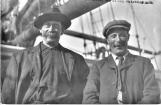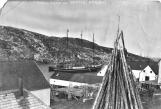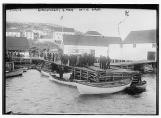1
Commander Robert Peary and Captain Bob BartlettSeptember 1909
Labrador
 Credits:
Credits:Courtesy of Ted Hardy, St. John's NL
2
Indian Harbour, Labradorcirca 1908-09
Labrador
 Credits:
Credits:Maritime History Archive, Memorial University of Newfoundland.
3
Battle Harbour, Labradorearly 1900s
Labrador
 Credits:
Credits:Courtesy of the Maritime History Archive, Memorial University of Newfoundland, St. John's NL
4
Roosevelt at Battle Harbour, LabradorSeptember 1909
Labrador
 Credits:
Credits:Courtesy of Ted Hardy, St. John's NL
5
Newspapermen on Battle Harbour wharf, LabradorSeptember 1909
Labrador
 Credits:
Credits:Courtesy of Ted Hardy, St. John's NL
6
On Sept. 5 1909 Commander Peary sent a message - 'We own the top of the world' - to the New York Times from the wireless station at Indian Harbour Labrador. The most sought after expeditionary prize of the times had been attained and the world was mesmerized by the messages wired from Labrador. The attention of the world was focused upon the New York Times with exclusive access to Peary. Newspapers sent their representatives to Sydney Nova Scotia with instructions to reach Battle Harbour Labrador, the salt fish entrepreneurial station where Peary was repairing and provisioning his ship 'the Roosevelt'.Battle Harbour was located some 425 miles up the Labrador coast from Sydney NS and was accessible only by boat. Newspapermen clamoured for transportation to Battle Harbour. The Associated Press correspondents hired the tug 'Douglas H. Thomas' and arrived in Battle Harbour on Sept 13 1909 after a sea journey made difficult by heavy winds and inclement weather. Their journey was accompanied by the fear that Peary had already left Battle Harbour and the ships would pass each other, a fear which necessitated several stops at communities with wireless stations where enquiries were made as to the whereabouts of Peary and his crew. Upon arriving in Battle Harbour and finding 'the Roosevelt' tied up at the dock, information about the attainment of the north pole was gleaned from expedition members on 'the Roosevelt'. A report giving a brief outline of Peary's expedition was wired to the Associated Press offices and published on Sept. 14 1909 (see newspaper article 'associated Press Tug Arrives' by Associated Press, published by The New York Times).
Although there were no other vessels available in Sydney, there were three available at North Sydney NS. One of which, 'the Tyrian', a cable ship owned by the Dominion of Canada and under the command of Capt. Dickson, was ordered to meet Peary and offer him passage to Sydney in advance of the Roosevelt. Correspondents in Sydney, notified of the pending departure of 'the Tyrian', scrambled for supplies, gear, and passage on the ship. More than twenty correspondents and photographers representing newspapers in New York, Boston, Brooklyln, Montreal, Charlottetown PEI,, and Sydney sailed from North Sydney at 7:30PM on Sept 13 1909 'to find the man who found the Pole'. In the rush to sail, a dozen correspondents, some representing magazines, were left on the wharf. Rough seas dogged the Tyrian's journey north and complicated landing the correspondents at Battle Harbour two days later.
"With the waves high and a choppy sea, the problem of landing the writers was a really dangerous one. Capt. Dickson got away in his gig first, rowed by a quartet of husky sailormen. As soon as he was clear of the ship the order was given to lower the port surf boat and immediately followed a wild scramble by photographers and correspondents for the honor of being in the first boatload. When the boat found the water a dozen men were clinging to the seats, and more piled in when it was brought to the companion ladder. Then, with the boatswain, William Goldman, at the steering oar, the four oars struck the water and the tiny craft headed for the entrance to the harbor. After half an hour's pull the heavily loaded boat reached the lee of the ledge of rock which forms a natural breakwater to the harbor ... All were thoroughly glad and as thoroughly wet when they rounded the entrance and beheld the Roosevelt lying at anchor. Beside her was the tug D.H. Thomas, and the Associated Press men gave a lusty cheer, which was answered by the new arrivals. Three more cheers were given for the Roosevelt and an instant later sixteen able-bodied newspaper workers were scrambling over the sides and the attack on the Roosevelt was begun" (from 'Dash of reporters to Battle Harbor', The New York Times, Sept. 20 1909).